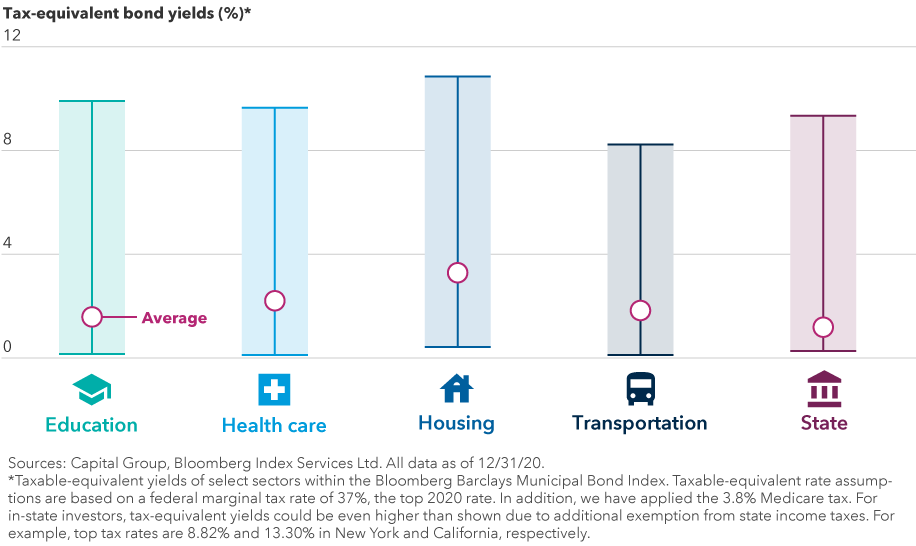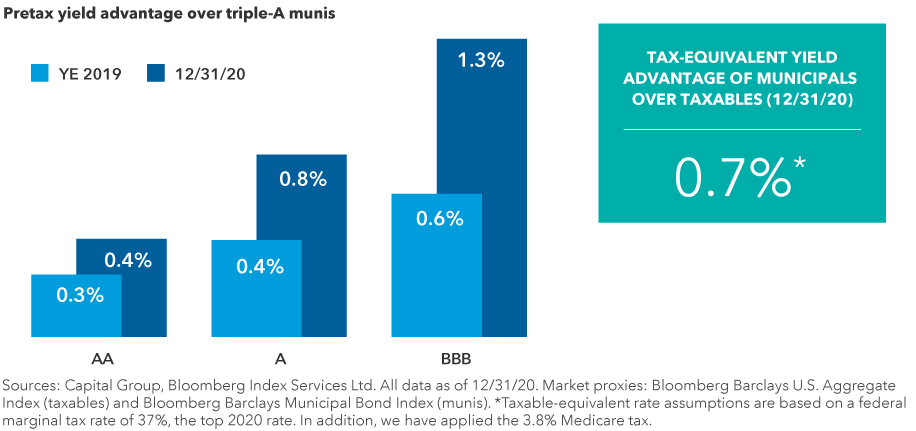Fixed Income
Bonds
- Municipal bond issuers have taken a pervasive revenue hit, though a rebound has begun and we do see some attractive value
- Downgrades look set to increase, while defaults should remain rare
- The pandemic and its economic fallout are reshaping opportunities for active investors
- Expect greater differentiation among sectors and credits as fundamentals diverge
Commuter trains with seats to spare at rush hour. Vacant dorm rooms. And, of course, hospital wards, stretched to capacity. The effects of COVID-19 on all our lives have been plain to see.
As municipal bond investors, however, it’s important to note that the pandemic’s impact on transportation, education and health care (among other sectors) has also been profound.
Although everyday life should return to “normal” with the rollout of vaccines, muni investors should prepare for uncharted territory. The pandemic and its economic fallout mean that 2021 will prove anything but business as usual. We anticipate that we’ll continue to see pockets of attractive value across the market, as well as weakness in certain areas.
Lost tax revenue is leaving some state and local governments with critical budget shortfalls. Likewise, a wide range of issuers in transportation, education, health care and other parts of the market have struggled with weaker revenues and higher costs.
All that almost certainly adds up to a more challenging investment environment. And yet, in today’s low-rate world, there’s a clear silver lining: improved tax-advantaged income potential.
So far, municipal valuations have not rebounded from the meltdown of March 2020 to the same degree as other global credit markets. For example, the Bloomberg Barclays Municipal Bond Index is yielding more than the Bloomberg Barclays Global Aggregate Index, even before adjusting for taxes. Yields already vary widely among and within municipal sectors. Looking forward, we expect to see even greater sector and credit differentiation as fundamentals diverge.
Income potential varies widely among municipal sectors

Yields and returns among muni bonds will likely vary more widely and that’s OK. As Karl Zeile, a portfolio manager for several funds including The Tax-Exempt Bond Fund of America® and American High-Income Municipal Bond Fund® has noted: “It’s just the kind of environment where active managers like us can really prove our mettle.”
With all that in mind, here are four key themes we’re keeping an eye on in 2021:
1. Downgrades could accelerate, but widespread defaults are unlikely
Lower sales and income tax receipts are putting a sizable hole in state and local government budgets. In some states with economies that are reliant on tourism, sales and income taxes have declined by double-digit percentages. Total budget gaps across all 50 states could total several hundred billion dollars in 2021.
Rainy day funds have helped lessen the impact of lost revenues. In many states, these budget stabilization funds (as they’re formally known) could be exhausted by year-end.
On the other hand, state and local governments can raise revenues and cut expenses to offset these fiscal challenges. Many issuers will also benefit from the economic boost that results from the new $900 billion federal stimulus package that was signed into law in late December.
Even though the revenue hit to states hasn’t been as severe as initially feared, some investors remain concerned about the possibility of defaults and bankruptcies. It’s therefore important to note that municipal defaults and bankruptcies have been relatively rare.
Analyses by Moody’s Investor Service (for the period 1970 through 2018) laid bare the contrasting default trends of municipals and global corporates. For example, the 10-year cumulative defaults rate for high-yield munis and corporates were 7.5% and 28.8%, respectively. For investment-grade issuers, the rates were just 0.1% and 2.3%, respectively.

2021 Outlook webinar
Get insights for 2021 and beyond
States are not able to file for relief under Chapter 9 of the U.S. Bankruptcy Code, and filings by counties and cities have typically numbered 10 or fewer per year in the past decade. On average, the annual number of defaults across all sectors has been in the double digits, and almost all have occurred in the nonrated segment of the market.
For context, the municipal market includes tens of thousands of issuers and hundreds of thousands of securities. Senior housing and industrial revenue bonds accounted for much of the dollar value of defaults in 2020, and none of these issuers were rated investment grade prior to the pandemic.
Revenue bonds account for most of the municipal market. Each bond is backed by a dedicated revenue stream from a specific project — anything from a hospital to a toll road. Unlike general obligation (GO) bonds, they therefore have very little connection to state and local government finances.
For the foreseeable future, downgrades among revenue bonds will likely remain elevated compared to recent years, and may accelerate in 2021. Even so, except for the sharp rise in downgrades seen in the second quarter of 2020, the trend hasn’t been as grave as during the global financial crisis. Back then, downgrades jumped at the onset in 2008, and remained elevated for a few years. It seems prudent, therefore, to prepare for a period of greater downgrade risk.
Default history and distressed yields highlight potential trouble spots
.png)
2. Opportunities in education, hospitals and senior living are being reshaped
High unemployment levels and some setbacks for consumer spending have meant less tax revenue going into state coffers. This, in turn, may result in reduced official expenditure on both education and health care. Here are our thoughts on some key sectors:
Higher education. Online and hybrid learning will potentially reduce income from tuition fees and state budget cuts could impact some public universities. On the expense side, teacher salaries often dominate spending and, because of the “tenure” system, can’t easily be reduced. Profit margins will likely trend lower, and balance sheets could weaken as schools are forced to free up cash to help cover operating expenses.
School districts. Most continue to collect their reimbursements from states, even if they have switched to fully remote or hybrid learning. Providing technology to students for remote learning has resulted is some increased spending, but the pandemic has so far had a fairly muted impact on fundamentals.
Not-for-profit hospitals. Nationwide, hospitals experienced temporary revenue and volume declines due to loss of elective and non-urgent procedures. Many systems have tapped the bond market to help bolster liquidity at relatively low interest rates, while also deferring capital investments. Fundamentals heading into this downturn were generally stronger than witnessed in the Great Recession, and federal support has also provided a lifeline. Even so, this is shaping up to be a tough year for the sector. Mergers and acquisitions activity will likely reaccelerate as struggling hospitals seek out new partners.
Senior living. We’ve seen a marked divergence here. Fundamentals for well-run projects with high occupancies and sound management teams are showing resilience. On the other hand, fundamentals among weaker credits have deteriorated. Overall, this sector may bounce back strongly as pent-up demand is unleashed, once vaccinations become more widespread.
Some potential COVID winners and losers in three key muni sectors
.png)
3. The transit sector could take years to fully recover
Transportation is another area where we see growing divergence. Toll road bonds, for example, have rallied and regained much of the ground lost earlier in 2020, while mass transit credits continue to suffer.
Greater numbers of people working from home or favoring alternate transportation has prompted a collapse in transit ridership and, therefore, fare collections. At the same time, many transit agencies are heavily subsidized through sales taxes, payroll taxes and other revenues. Many of these revenue streams have also taken a major hit.
As a result, risk is elevated across the sector, and it will likely be several years before revenue streams recover to pre-pandemic levels. Mass transit has often accounted for a greater share of lower rated issuance among transportation bonds. We’ve already seen high-profile downgrades, and volatility may rise as systems feel increased financial pressure. That being said, funding mixes do vary among mass transit systems. Furthermore, some may be deemed essential to the functioning of local and regional economies — making them potentially strong candidates for extra state or federal support.
4. Expect yields and returns to vary more widely as fundamentals diverge
As noted in our sector-specific views, diverging fundamentals will lead to greater variation in yields and returns within the asset class.
Pockets of value are also apparent when viewing the market through the lens of credit quality. For example, before adjusting for the tax exemption, BBB municipal yields are more than 100 basis points above comparable maturity U.S. Treasuries (and, indeed AAA-rated municipals).
This yield gap is well above what we witnessed pre-pandemic. Amid overall normalization in municipals and other fixed income markets, this differential hasn’t narrowed back down because uncertainty still hangs over the outlook. Given ongoing questions around the short- to intermediate-term financial health of states and other municipal issuers, it’s perhaps not surprising that lower quality municipal credits are most affected.
Lower rated investment grade is a sweet spot among munis

Final thoughts
The pandemic’s immediate impact on municipal issuers has been cushioned by massive policy responses. Federal fiscal aid provided as part of the $2.2 trillion pandemic stimulus package in March 2020 and the Federal Reserve’s Municipal Liquidity Facility were both hugely helpful. Many states, for example, managed to record less severe declines in revenues for the fiscal year ended June 2020 than they had initially feared. The new $900 billion federal stimulus package could prove similarly supportive.
Even so, 2021 is shaping up to be quite different. Uncertainties about the precise path of economic recovery and how quickly vaccination will turn the tide on the pandemic all loom large. The Democrats’ victory in Georgia’s runoff elections on January 5 is also potentially significant. With Democrats controlling the U.S. Senate, it may be more likely that state and local aid will pass under the new administration. This development could benefit certain parts of the market such as governmental and transportation bonds. It’s likely to be a year where careful municipal bond selection, built on issuer by issuer research, will be especially important.
The market indexes are unmanaged and, therefore, have no expenses. Investors cannot invest directly in an index.
The return of principal for bond funds and for funds with significant underlying bond holdings is not guaranteed. Fund shares are subject to the same interest rate, inflation and credit risks associated with the underlying bond holdings. Lower rated bonds are subject to greater fluctuations in value and risk of loss of income and principal than higher rated bonds. Income from municipal bonds may be subject to state or local income taxes and/or the federal alternative minimum tax. Certain other income, as well as capital gain distributions, may be taxable. The use of derivatives involves a variety of risks, which may be different from, or greater than, the risks associated with investing in traditional cash securities, such as stocks and bonds.
Bond ratings, which typically range from AAA/Aaa (highest) to D (lowest), are assigned by credit rating agencies such as Standard & Poor's, Moody's and/or Fitch, as an indication of an issuer's creditworthiness. If agency ratings differ, the security will be considered to have received the lowest of those ratings, consistent with the fund's investment policies. Securities in the Unrated category have not been rated by a rating agency; however, the investment adviser performs its own credit analysis and assigns comparable ratings that are used for compliance with fund investment policies.
Bloomberg Barclays Global Aggregate Index represents the global investment-grade fixed income markets. Bloomberg Barclays High Yield Municipal Bond Index is a market-value-weighted index composed of municipal bonds rated below BBB/Baa. Bloomberg Barclays U.S. Aggregate Index represents the U.S. investment-grade fixed-rate bond market. Bloomberg Barclays Municipal Bond Index is a market value-weighted index designed to represent the long-term investment-grade tax-exempt bond market. Bloomberg® is a trademark of Bloomberg Finance L.P. (collectively with its affiliates, “Bloomberg”). Barclays® is a trademark of Barclays Bank Plc (collectively with its affiliates, “Barclays”), used under license. Neither Bloomberg nor Barclays approves or endorses this material, guarantees the accuracy or completeness of any information herein and, to the maximum extent allowed by law, neither shall have any liability or responsibility for injury or damages arising in connection therewith.
RELATED INSIGHTS
-
Fixed income outlook: Resilient U.S. provides an anchor
-
Global Equities
Stock market outlook: AI leads a broadening market -
Economic Indicators
Economic outlook: Global growth dependent on a resilient U.S.
Don’t miss out
Get the Capital Ideas newsletter in your inbox every other week
 Neil Amirtha
Neil Amirtha
 Aditi Gupta
Aditi Gupta
 Greg Ortman
Greg Ortman